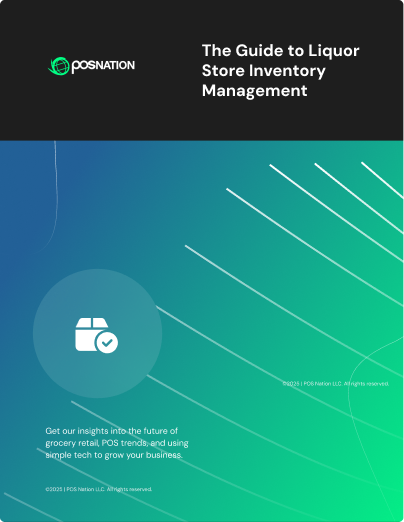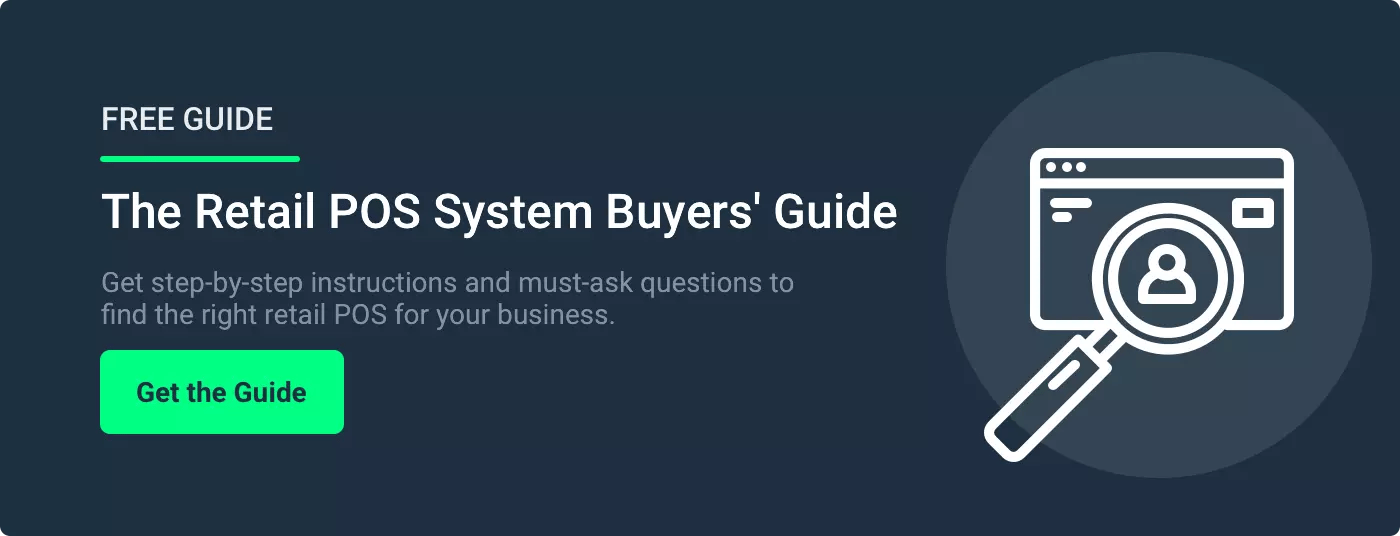Every customer interaction, stocked shelf, and staffing decision adds up. Stock too much seasonal beer, and it goes bad. Schedule too few cashiers on Friday night, and customers leave.
When one wrong call can shrink your margins, the difference between growth and stagnation often comes down to a few critical retail management strategies.
Here are nine practical ideas you can implement today to simplify operations and improve your bottom line.
1. Track Inventory in Real Time
Don’t wait for a stock check to discover issues. Your point of sale (POS) system can track inventory as items are sold — flagging shortages, slowing excess orders, and keeping your shelves stocked with what customers want.
Use it to:
-
Set low-stock alerts on fast-selling items so you can reorder before customers walk away empty-handed.
-
Identify slow movers early and mark them down before they tie up storage space and cash.
-
Automate reorders based on real sales trends, rather than static par levels.
For example, if pumpkin spice lattes or summer energy drinks slow down mid-season, reports in your POS system can spot declining sales trends. This gives your convenience store time to discount or re-merchandise before they expire or take up valuable cooler space.
2. Create a Customer-Friendly Store Layout
Store layouts influence how customers move through your store and what they put in their carts. Plan your store layout to direct the flow of foot traffic, encourage exploration, and use every square foot of the sales floor.
Take advantage of your POS system data to adjust your floor layout and highlight what sells:
-
Put top-selling or high-margin items at eye level and in high-traffic areas like endcaps or checkouts.
-
Keep the entrance clear, but place promo or new arrivals displays just beyond it to draw shoppers further into the store.
-
Cross-merchandise products and services that are often bought together.
-
Rotate underperforming displays or product categories every few weeks, and track whether placement changes lead to improved sales.
For instance, a liquor store might display a tequila bundle, including a bottle, lime juice, and branded glasses, near the entrance right before Cinco de Mayo.
3. Build a Loyalty Program That Pays Off
Loyalty programs turn everyday data into tangible results. And when you have these programs built into your POS system, you can launch targeted promotions, increase basket sizes, and encourage customers to return and shop again.
How to make loyalty programs that generate revenue:
-
Set spend-based rewards that match your pricing model.
-
Group buyers by category, like cigars, snacks, or local wine, to send relevant offers.
-
Send rewards based on past purchases, not assumptions.
-
Let customers access rewards and receipts via an app or text.
If you own a tobacco shop, try offering every fifth cigar free to repeat buyers, with rewards automatically tracked and redeemed through your POS system.
4. Use Sales Data To Guide Promotions
If you want promotions that drive sales, base them on real numbers, not just what seems to be working.
Your POS reporting tools can show you what’s selling, what isn’t moving, and how different offers perform.
Use that information to:
-
Compare past promotions side-by-side in your POS reports to see which ones actually moved product, and which ones flopped.
-
Break down results by category, vendor, or daypart to find your top performers.
-
Identify which products sell without a discount, and which only sell when marked down.
For example, grocery store owners could run a buy one, get one (BOGO) deal on strawberries one week, then test a 25% markdown the next, tracking which promotion clears more units and delivers better returns.
5. Train Employees With Clear Procedures
Retail has the highest turnover rate of any industry at 60.5% — but it doesn’t have to interfere with your store’s workflow. When training is easy to follow, new employees learn the ropes quicker, feel more confident, and make fewer mistakes.
Your POS system can help organize step-by-step instructions for tasks like opening the register, processing returns, or closing out at the end of the day. To standardize training and daily routines:
-
Assign staff permissions to match job roles and responsibilities.
-
Tie shift checklists to register logins or time clock entries.
-
Review team sales data to highlight training gaps and recognize top performers.
For tobacco retail businesses, that often involves age verification prompts at checkout. Clerks must scan IDs or input birthdates before the sale can proceed, reducing the risk of underage transactions.
6. Embrace Omnichannel Selling
Retail customers now expect flexible ways to browse, buy, and receive products. Connecting your online and brick-and-mortar business operations through your POS systems helps you meet customer demand without doubling your workload or miscounting inventory.
How to manage multiple channels without increasing your workload:
-
Connect to accounting software to reduce manual work and speed up bookkeeping.
-
Offer in-store pickup or local delivery based on real-time availability.
-
Use QR codes to drive digital traffic from physical displays or packaging.
-
Monitor online and in-person sales together to adjust promotions or pricing.
During peak morning hours, convenience stores can feature breakfast sandwiches and coffee bundles online, giving commuters the option to pre-order and skip the line.
7. Automate Back Office Tasks
Retail business strategies involve several behind-the-scenes activities, like ordering, tracking margins, and syncing vendor data. Automating these tasks through your POS system reduces errors, shortens end-of-day workloads, and gives you real numbers to make data-driven decisions.
Use your POS system to:
-
Track margins by product, vendor, or category automatically.
-
Generate reorder reports so you’re buying based on sales, not habit.
-
Sync with accounting tools to simplify tax prep and cut down on data entry.
Liquor retailers, for example, use POS-generated purchase orders to stock up on top-selling spirits ahead of busy weekends, helping them avoid missed sales and last-minute ordering.
8. Schedule Smarter and Cut Labor Waste
Labor is one of the biggest line items in retail, costing up to 20% of total sales. So, managing your staff has a direct impact on profitability. POS-connected scheduling tools help you match staffing to real sales patterns.
Use these POS-backed tips to make scheduling decisions that lower labor costs and maintain excellent customer service standards:
- Match shift coverage to peak sales hours using historical transaction data.
- Reduce excess labor by flagging underperforming time blocks.
- Adjust weekend or holiday staffing based on foot traffic trends.
- Track your labor-to-sales ratio — a simple metric that shows how much you’re spending on staff compared to what you’re making — to see which shifts deliver and which fall flat.
For example, a boutique owner might reduce staffing midweek afternoons after POS reports show that most sales come from quick, single-item purchases, not the longer, high-touch styling sessions that require more support.
9. Personalize the Customer Experience
Personalization is one of the most effective retail management strategies for increasing customer retention and spend. When your POS system tracks preferences, you can tailor outreach to improve customer service.
Use your data to:
-
Customize receipts with related product suggestions or limited-time offers.
-
Send personalized texts or offers tied to a shopper’s last visit.
-
Link loyalty accounts to mobile numbers for faster recognition at checkout.
-
Group customers by what they buy most — snacks, tobacco, wine — and send deals they’ll care about.
If you operate a cell phone store, you can send SMS messages with limited-time offers on phone cases or earbuds to customers who recently purchased related devices.
Retail Management Strategies That Deliver Real Results
Retail management strategies aren’t theory — they influence how your store performs day to day. With the right tools, it’s easier to react quickly, reduce wasted resources, and build more profitable routines.
POS Nation gives you the tools to do it. With POS systems built for grocery, convenience, liquor, tobacco, cell phone, and general retail, you get features that match your workflow. Use real-time inventory tracking, vendor reports, and reorder tools to implement your strategy, and access functions tailored to your industry from day one.
Use POS Nation’s Build and Price tool to create the perfect software system to simplify business management.








 by Spence Hoffman
by Spence Hoffman

 by Graham Hoffman
by Graham Hoffman
